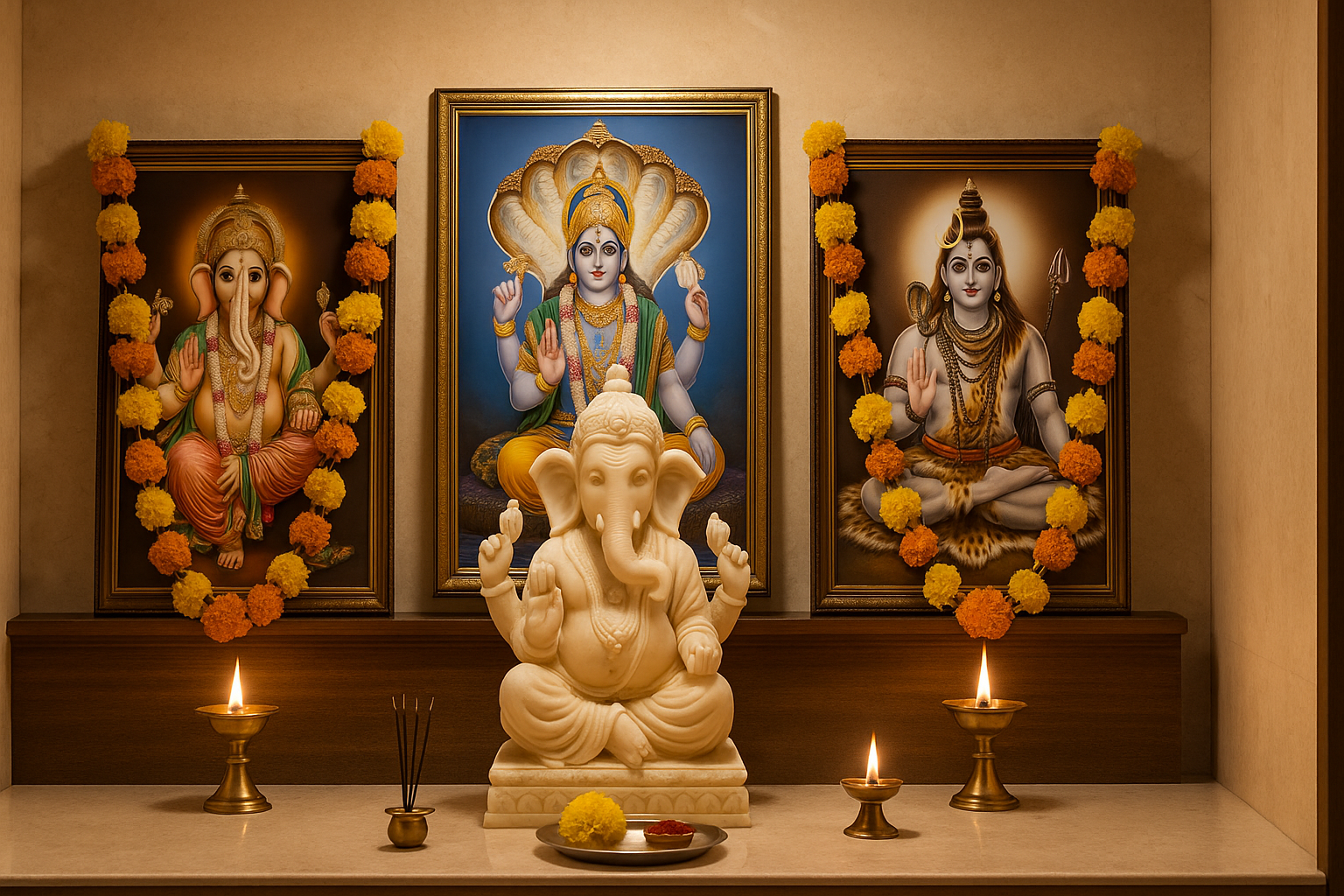A pooja room is the holy corner of an Indian house. Families gather here to pray, meditate and connect with divine energy. One of the most common questions is: In which direction should God face in the pooja room?
According to Vastu Shastra and traditional beliefs, the direction of the deity and the devotee is very important. It balances, spreads positive energy, and ensures peace in the house. Let’s look at it in detail with accurate information.
Why does the direction in the Pooja Room matter?
The ancient Indian science of architecture, also referred as Vastu Shastra, states that every direction carries a unique energy. The correct placement of the puja room and idols ensures that energy flows properly. When you follow these directions, the house feels calm and prayers feel more powerful. While faith is most important, the direction helps to align the energy of the house with nature.
What is the best place for a Pooja Room at home?
The most auspicious place for the puja room is the Northeast corner (Ishaan Kon). It is believed that this direction is full of divine energy. If this is not possible, then the next best option is east or north side of the house. These directions allow morning sunshine and fresh energy to enter the space, making the mandir space bright and positive.
The escape places include the bedroom, the area under the stairs, and the near or contrasting bathrooms. Such areas of the pooja room disturb the sanctity of the space. A worship room should always be clean, peaceful and different from chaos.
Which Direction Should God Face?
This is the core question. According to Vastu and tradition:
- East-facing idols: Considered the most auspicious. If the idol faces east, the devotee will sit facing west while praying. This brings prosperity and peace.
- West Facing Idols: Also good. Here, the devotee faces east while praying, which is highly favourable as it connects with the rising sun.
- North-facing idols: Acceptable in some cases. North is linked to success and wealth. Lord Kuber, the god of wealth, is often associated with this direction.
- South-facing idols: Not recommended for home mandirs. The south is linked with Yama (the god of death) and is avoided for daily worship. While some temples may have deities facing south for specific reasons, at home, this direction should be avoided.
Which Direction Should the Devotee Face?
The direction of the worshipper is equally important. Facing east is ideal, as it symbolises new beginnings and connects with positive solar energy. Facing north is also good for those seeking growth and prosperity. Facing south during prayers is not advised.
So in short, the idol should be placed so that the devotee can face east or north while praying.
Know how to Set Up the Pooja Room:
Certain practices keep the puja room pure and full of energy:
- Idols should not touch the wall directly; leave a small gap for air circulation.
- Place idols at a moderate height above the floor, not directly on the ground.
- Keep the pooja room clean and clutter-free at all times.
- Use natural light whenever possible. If not, ensure the space is well-lit.
- Always light a diya (lamp) or incense stick while praying to create positivity.
- Avoid storing non-religious items in the mandir.
Some Myths and Exceptions:
Some traditions, especially in South India, may have temples where deities face south. These are based on specific regional customs and should not be copied in home mandirs. In small flats or homes where ideal placement is not possible, don’t panic. Place the mandir in the cleanest and calmest space available. Devotion matters more than strict rules, but try to follow Vastu as much as your home allows.
Things to Avoid in the Puja Room
Vastu also explains what should not be done in a pooja room:
- Avoid keeping broken idols or torn pictures of God.
- Never store unwanted items in the pooja room.
- Do not keep the pooja room in the bedroom.
- Do not place the pooja room under a staircase or near the bathroom.
Keeping the pooja room clean and pure is as important as the direction.
What are the benefits of following Vastu for the Pooja Room?
When the pooja room is set up correctly as per Vastu:
- Positive energy flows freely in the house.
- Family members feel more peaceful and stress-free.
- Relationships improve with harmony and love.
- It attracts prosperity, health, and spiritual growth.
This is why so much importance is given to directions and placement.
Some Practical Tips for Homeowners:
Not everyone has the perfect house plan, but a few simple steps can help:
- Use a compass or a mobile app to confirm directions before placing idols.
- If northeast placement is not possible, consider east or north instead.
- If the space is very small, dedicate even a small cabinet or shelf for the mandir. Keep it simple and clean.
- Paint the pooja space in soft colours like white, cream, or light yellow to maintain peace.
- Fresh flowers, clean cloths, and daily rituals make the mandir more divine than just the direction.
Conclusion
The best practice is to place your pooja room in the northeast corner of the house, with the deity facing east or west so that you can pray facing east or north. Avoid south-facing idols and keep the space pure, bright, and peaceful. While direction and placement are important, true spiritual energy comes from devotion and sincerity. When faith is combined with purity and sacred essentials like Satvikly oils and ghee, your home naturally fills with peace, positivity, and divine blessings.

